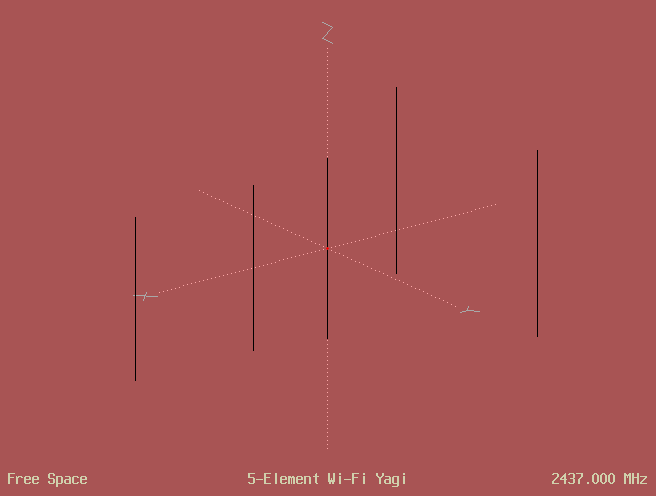K6sti Antenna Optimizer
ANTENNA OPTIMIZERS. • YO – Yagi Optimizer from Brian Beezley. • AO – Antenna Optimizer also from K6STI. • Both of these based on MiniNec which isn't as accurate and flexible as NECOPT. • Other optimizers out there too but none seem to be as powerful as NECOPT. Jul 29, 2013 - Brian Beezley, K6STI designed a 9-element Yagi for the 88-108 MHz VHF-FM band with a horizontal folded dipole and three reflectors. His antenna optimizer managed to achieve 7-8 dBd gain and F/R up to 30dB over entire bandwidth. The distance between first and last element is 100″ or 254 cm.
Hi-VHF 5-El Yagi Optimized by K6STI holl_ands >>Hi-VHF 5-El Yagi Optimized by K6STI K6STI's Hi-VHF 5-Element Yagi with Rearward Swept Driver Element analyzed using 4nec2. 4nec2 files are included in *.doc format, providing all dimensions. Save as *.txt format then rename as *.nec.
4nec2 files can also be imported into EZNEC and other antenna simulation programs. Brian Beezley, K6STI, used his AO 8.06 Antenna Optimizer to find a configuration that minimized response to the rear. On 19Jun he replaced Original with slightly revised RevA, which has improved SWR and Gain: K6STI's Optimized Yagi design is only 31.4-inches long and 32.4-inches wide, but provides good coverage across all Hi-VHF channels (Ch7-13) with excellent Front-to-Rear (F/R) and Front-to-Back (F/B) Ratios and moderate (7.4-9.3 dBi) Net Gain. Although slightly longer, performance differences between versions are very small, mostly reflecting fine tuning. In 4nec2 analyzes, F/R is the ratio of gain towards the front (azimuth = 90-deg) to gain towards the rear (azimuth = 180-deg). And F/B is ratio of gain exactly towards the front to gain towards the rear with an included angle of (my choice) +/- 45-deg. This is different than the worst side-lobe level calculated by K6STI.

Note that 4nec2 calculated SWR is slightly higher than K6STI's. I also investigated a Folded Dipole variant which has a Characteristic Impedance of 300 ohms (vice 75-ohm for above). After optimizing Folded Dipole Element separation, SWR was further reduced to under 1.4 with up to 0.25 dB more gain on Ch13 than K6STI's Yagi RevA, with small increase in F/R and F/B (except Ch12-13 decreased some). [Further optimization is possible.] DIYers can consider whether the small mis-match loss of a 1:1 Coax Balun (or direct connect) is smaller (or greater) than the small (0.5 dB) loss in Hi-VHF band for a low-loss 4:1 Balun, as discussed HERE: Gain, F/B and F/R are compared to 4-El K7MEM Yagis (only 2-3 channels), 8-El K7MEM Yagis (only 3 channels), as well as fol. Full band antennas: 14-Element ZS6BTE LPDA, 14-El Wedge Zig-Zag LPA and 14-El Stacked Zig-Zag LPA.
All of the 8-El and 14-El antennas are much longer (about 100 inches), with higher gain. An open challenge is to design a compact HIGH GAIN Hi-VHF antenna with FULL-BAND coverage. EDIT (20Jun2009 @ 08:10am): Updated charts to reflect comparison of RevA to Original. G Sonic Motherboard Drivers Free Download.
EDIT (19Sep2010): Added FORWARD Gain and SWR (75-ohm) charts for UHF Band.although it might pick up strong signals, it does NOT provide good performance in the UHF Band. Date(s): June 20, 2009. Album by holl_ands. 1 - 29 of 29 Total. 12809 Visits.
Enlarge 0KB, 1024x764 1 Hi-VHF 5-El K6STI Yagi with Swept Back Driver RevA - 3D View Red circle at center of swept element identifies a short 'simulated SOURCE wire'. Enlarge 0KB, 1024x937 2 Hi-VHF 5-El K6STI Yagi RevA - Top View [One small box = 0.5 inch] Click on image to see hi-rez. Enlarge 0KB, 1024x119 3 Hi-VHF 5-El K6STI Yagi RevA - Side View [One small box = 0.5 inch] Click on image to see hi-rez. Enlarge 0KB, 1024x747 4 Hi-VHF 5-El K6STI Yagi - Compare Raw & Net Gains Top: Folded Dipole (300-ohm) variant. Middle: RevA K6STI design. Bottom: Original K6STI design.
Enlarge 0KB, 1024x747 5 Hi-VHF 5-El K6STI Yagi - Compare SWR Note K6STI's calculated SWR was lower than 4nec2, but still showed increase on Ch13 enlarge 0KB, 1024x747 6 Hi-VHF 5-El K6STI Yagi - Compare F/R and F/B Ratios Excellent suppression of signals coming from the rear. 'Rear' is very narrow angle towards the rear. 'Back' includes response +/- 45-deg from 'Rear'. Enlarge 0KB, 1024x747 7 Compare 5-El K6STI Yagi RevA to 4-El K7MEM Yagis K7MEM (DL6WU equations) provides higher gain but only for two adjacent channels.
